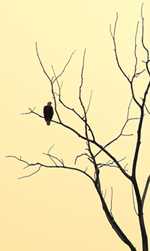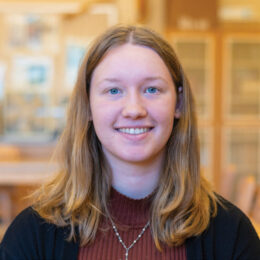
Ken Brunswick, a DNR ecologist who helped create the preserve, and Matt Smith, a volunteer, work side-by-side planting plugs of prairie cordgrass near a lake at Loblolly one evening in May. Brunswick, a Jay County REMC consumer, and his efforts to turn Loblolly back into a wetland were featured in the August 1997 Electric Consumer.
Ten years ago, restoration began on small sections of the long-lost Limberlost, the inspiration to Hoosier writer and naturalist Gene Stratton-Porter a century ago.
From the limb of a tall dead tree, a lone and lordly bald eagle perched undisturbed and almost unnoticed. It looked down over a shallow lake lined with reeds and cattails and kept a keen eye on a curious group of “gardeners” in the distance.
The group — members from a local 4-H club and two other volunteers — paid little mind to the national symbol just a quarter mile away. They were too busy planting on this sunny late spring afternoon. But it wasn’t corn or beans they sowed.
Stooped over in an ankle-deep bog, the group, along with two Department of Natural Resources ecologists, set plugs of Tussock sedge, a perennial wetland grass. Then they all moved to slightly higher ground to plant prairie cordgrass. In all, some 900 plugs of sedges and native wetland grasses were planted that day at the Loblolly Marsh Wetland Preserve.
The state preserve in northern Jay County celebrates its 10th birthday — or rather, the 10th anniversary of its rebirth — this month. In June 1997, the Loblolly Marsh, a wetland restoration project, was dedicated. It was named for the area’s original Miami Indian epithet meaning “stinking river.”
The 428-acre preserve was once part of the legendary Limberlost, an imposing wetland of marsh and swamp. The wetland covered 13,000 acres of northern Jay and southern Adams and Wells counties near the Wabash River. But beginning in the late 1800s, the wetland was drained for its gas and oil deposits, a common practice at the time. Its timber was harvested, and the cattails and sedges were replaced by corn and soybeans. By 1913, the Limberlost was lost.
The plantings at the preserve last month continue the slow but steady work to turn back time. A shallow lake has been re-established. Smaller ponds also have collected. Native wetland plants are flourishing in these areas. Geese, ducks, woodcocks and other water fowl feed and nest among the returned habitat. Great blue herons and even sandhill cranes and bald eagles make regular visits.
Trails, signage and a handicapped-accessible boardwalk have been added to enhance the experience for human visitors at the site.
College of the Limberlost
Matt Smith was one of those volunteers working last month at the preserve. The high school sophomore from southern Adams County has volunteered there the last two years.
 Smith’s affinity for birdwatching originally brought him to Loblolly. Those visits led to his volunteer work. “I’ve had an interest in wildlife for a long time,” the 17-year-old said. “They’ve got some pretty rare birds coming here.”
Smith’s affinity for birdwatching originally brought him to Loblolly. Those visits led to his volunteer work. “I’ve had an interest in wildlife for a long time,” the 17-year-old said. “They’ve got some pretty rare birds coming here.”
Smith said he’s never read anything by famed Hoosier writer Gene Stratton-Porter, who, a hundred years ago, found fortune in the original Limberlost. But he seems to be following in her early footsteps. The Loblolly Marsh is part of her old stamping grounds. She might suggest Smith, with his love of birds, is now also a part of the “college of the Limberlost” she wrote about, a school of nature’s experiences that teaches a person to think and feel.
Stratton-Porter parlayed her love of nature into a successful writing career. Living on the fringe of the swamp in Geneva, she increasingly ventured into the wetlands to first observe, then preserve with pen and camera, the varieties of birds, wildlife and plants in their natural surroundings. In her work, she protested with passion the destruction of wetlands.
Her writings had incredible foresight. Only in the past few decades have the benefits of wetlands become increasingly apparent to all. Wetlands act as a sponge, absorbing excess rainfall and filtering sediment and contaminants that otherwise would run off into the rivers. They help reduce flooding down stream. They also provide habitat to rich varieties of wildlife.
The home she shared in Geneva with her husband and daughter is preserved as the Limberlost State Historic Site. The addition of the Loblolly Marsh 10 years ago and more recent acquisitions within the old wetland, such as the Limberlost Swamp Wetland Preserve on Geneva’s south side, give the historic site almost 1,400 acres of Stratton-Porter’s beloved wetland to interpret and share.
 Like Stratton-Porter, Smith’s love of birds began when he was a tot. His parents put out a bird feeder in the backyard each winter. He became fascinated — especially by the cardinals. “I like watching birds because of the pretty colors,” he said, “and it’s a challenge finding the ones you want to find.”
Like Stratton-Porter, Smith’s love of birds began when he was a tot. His parents put out a bird feeder in the backyard each winter. He became fascinated — especially by the cardinals. “I like watching birds because of the pretty colors,” he said, “and it’s a challenge finding the ones you want to find.”
With the plantings that bring back the natural wetland habitat, it’s hoped even a wider variety of the wildlife Stratton-Porter saw in the wetland will return.
This summer, Smith will be working at the marsh as a paid part-time employee of the Friends of the Limberlost, a non-profit group that supports the state historic site.
Soil and water
Ken Brunswick stood beside a large concrete drainage inlet placed along one of the new trails at the Loblolly Marsh. Next to it were various sizes of plastic pipes. The artifacts, unearthed by the DNR when the wetland restoration began, were parts of the multiple, yet futile, attempts to keep the water from gathering on the land over the decades.The first thing that had to be done to restore the site was remove or plug the manmade drainage systems within the property. Brunswick, the DNR ecologist who oversees the restoration, said the tiles are used today to show school groups and other visitors how the land was drained.
“When we started restoring it, there were seven different tiles from four different landowners trying to drain that [same piece of ground] so they could grow crops,” Brunswick noted, “… and they were still losing crops.”
 The tiles and ditches drained the shallow lakes. But every time it rained, Mother Nature attempted to reclaim what was hers. Thousands of acres within the old, slowly draining wetland flooded. Three out of every four years, crop loss would be substantial.
The tiles and ditches drained the shallow lakes. But every time it rained, Mother Nature attempted to reclaim what was hers. Thousands of acres within the old, slowly draining wetland flooded. Three out of every four years, crop loss would be substantial.
“All these lost crops …,” Brunswick added, “… that was all federal money that went in here with crop insurance. Corn and soybeans are not aquatic plants. When you get floods, they can only take a few days of it, and they’re gone.”
Brunswick had been a farmer himself. In 1976, he moved his family from western Ohio to a small farm in northern Jay County. His home on the south side of State Road 18 looked out over acres of farmland to the north that would flood almost every year. A fan of Stratton-Porter’s nature books as a boy, Brunswick never realized he was looking out over what had been part of the Limberlost. Today, that section is the Loblolly Marsh. He said he believes it was more than just coincidence he settled his family on that piece of land. He said there was something divine involved. “I came here for a reason,” he said.
In 1993, Brunswick gave up farming to pursue what he felt had been his life’s true calling. At age 47, he enrolled at Ball State University to begin a second career — natural resources. Soon, he put together a coalition of conservation and preservation groups, government agencies and, most importantly, landowners that allowed the land for the Loblolly preserve to be purchased by Friends of the Limberlost and turned over to the state. After he earned his degree in 1998, the DNR hired him to work on the Limberlost restoration.
Leaving a legacy
Bettie Jacobs also combines her day job with her passion — conservation. She’s the coordinator/educator with the Jay County Soil and Water Conservation District. She’s also the leader of the Portland 4-H Soil and Water Club. When she took over the club a few years ago, the club had not one member. She drafted her niece and enlisted a few other kids. Now the club has grown to 10 members, and she’s tickled. “Conservation was very big with my father, and I want to leave the same legacy.”
 Jacobs, known as the “Worm Lady” to students in the county for her entertaining school programs, said her 4-H group visits the Loblolly wetland each season. “A lot of people don’t know this exists out here,” she said. “Not enough people take advantage of it. That’s a bald eagle in that dead tree over there … now where are you going to see that?”
Jacobs, known as the “Worm Lady” to students in the county for her entertaining school programs, said her 4-H group visits the Loblolly wetland each season. “A lot of people don’t know this exists out here,” she said. “Not enough people take advantage of it. That’s a bald eagle in that dead tree over there … now where are you going to see that?”
This trip, her kids helped plant the plugs of wetland grasses. “Conservation is in the hands of our future,” said Jacobs, a Jay County REMC consumer, “… and these kids are our future.”
Jana Shaffer could hardly believe her eyes. From the county road that dissects the Loblolly Marsh, the Jay County REMC consumer spied the same large bird Jacobs pointed to a quarter mile away. Though silhouetted by the late afternoon sun, the bird appeared to have a white head when she looked through her binoculars. “That can’t be an eagle,” she said. “That can’t be a bald eagle!”
Unsure of what she thought she was seeing, she asked another group of bird watchers in a van that had paused farther down the road. They specifically had come to see the bald eagle. The driver, Carolyn Geesaman of Portland, confirmed it. She had seen the same eagle there the evening before and came out again.
“I have goosebumps,” Shaffer said. “I just can’t believe it. I had heard there was one in the wetland, but I had never seen it.… Isn’t that the most amazing thing? It’s just magnificent.”
The rural mail carrier said she often comes to Loblolly after work to enjoy the quiet and watch the birds. It “de-stresses” her, she said.
The preserve has come along slowly, Shaffer added. “But we knew it would.”
What the Loblolly has already delivered to a new generation of nature lovers and conservationists is just an inkling of what it will provide later this century as it returns to a smaller version of the natural wetland it was.
“I just love coming down here. It is so peaceful. But this,” said Shaffer, taking another long look through her binoculars at the bald eagle, “is really special.” — Story by Richard G. Biever, senior editor
You can still support the Limberlost restoration by contacting the Friends of the Limberlost, P.O. Box 571, Geneva, IN 46740, or calling (260) 368-7428.



